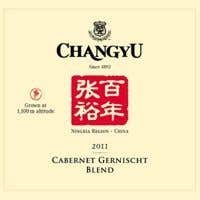Buy this wine
By complete coincidence, the British supermarket group Waitrose introduced a wine from Ningxia, their first-ever Asian wine, at exactly the same time as I visited China's most wine-friendly province a couple of weeks ago. You can read some background to the region in The vinification of Ningxia. There's an account of a local wine competition and my tasting of more than 50 Ningxia wines in this tasting article, and I will be publishing an overview tomorrow.
Ningxia is certainly a fascinating place, not least because the local government is so keen to make it China's leading wine province. But in my tasting of the local reds (which outnumber the local whites by a considerable margin, as is the Chinese way), I kept coming across a very distinctive and not altogether pleasant flavour, something almost aggressively green and peppery. This turned out to be the local grape speciality, the variety known in China as Cabernet Gernischt, probably a mistaken transcription of Cabernet Gemischt, or 'mixed Cabernets', on some cuttings. Our co-author of Wine Grapes, José Vouillamoz, managed to get samples of this variety from China's biggest winery Changyu to analyse their DNA and established that Cabernet Gernischt is in fact Carmenère, the old Bordeaux variety now so common in Chile. Hence the green note, for it is evident in many examples of Carmenère grown even in the much hotter climate of Chile.
government is so keen to make it China's leading wine province. But in my tasting of the local reds (which outnumber the local whites by a considerable margin, as is the Chinese way), I kept coming across a very distinctive and not altogether pleasant flavour, something almost aggressively green and peppery. This turned out to be the local grape speciality, the variety known in China as Cabernet Gernischt, probably a mistaken transcription of Cabernet Gemischt, or 'mixed Cabernets', on some cuttings. Our co-author of Wine Grapes, José Vouillamoz, managed to get samples of this variety from China's biggest winery Changyu to analyse their DNA and established that Cabernet Gernischt is in fact Carmenère, the old Bordeaux variety now so common in Chile. Hence the green note, for it is evident in many examples of Carmenère grown even in the much hotter climate of Chile.
Put this together with the fact that much of the Cabernet Gernischt of Ningxia is apparently affected by leafroll virus, which slows ripening, and you have a recipe for considerable greenness. I was intrigued when, once back in London, I tasted a sample of Changyu, Cabernet Gernischt Blend 2011 Ningxia and found there was not a trace of greenness so asked the Austrian Lenz Moser, who is cited as a consultant to Changyu, how this had been achieved.
According to him, they reduced yields considerably, from the Ningxia over-generous norm of 25 tonnes/ha to a much more reasonable 10 at the most, which 'gave us a completely different base for winemaking – physiologically ripe grapes.' (So simple…!) They also used a considerable portion of softening Merlot in the blend along with Cabernet Sauvignon for structure. 'Cabernet Gernischt adds the spice, aromas we love. This type of assemblage (hence the wording on the label Cabernet Gernischt blend) creates something we believe will be the future for making China an international player. We do believe Ningxia is ideal wine-growing country – 3,000 hours of sunshine, 1,100 m of altitude and desert climate (plus irrigation) – and this is another important factor apart from the fact that Changyu has improved their technology dramatically in the last couple of years under the stewardship of Dr Li – Changyu's head oenologist.'
Changyu's original base is in the eastern wine region of Shandong. They are very good at marketing, have one or two extremely expensive Chinese wines on the market whose packaging is obviously a considerable factor in the price.
Here's my tasting note:
Changyu, Cabernet Gernischt Blend 2011 Ningxia 16 Drink 2012-2013
From China's biggest and oldest wine company. Smells leafily aromatic and more like Cabernet Franc than the usual greenness of Cabernet Gernischt (aka Carmenère). Tastes as though there is a little residual sugar – yes, 4.5g/l, according to the tech spec. Austrian Lenz Moser reports that they deliberately reduced yields and blended in quite a bit of Merlot as well as Cabernet Sauvignon to avoid greenness. This is obviously a fairly basic commercial wine (it certainly looks like it in terms of packaging) but is very clean, fresh, light to medium bodied and is a fine ambassador for Ningxia. Waitrose's first-ever Asian wine. 12.5%
£9.99 (£7.99 until 23 Sep) Waitrose
Like several others of the nearly 30 wineries in Ningxia, Changyu have built an extraordinarily ambitious vast copy of a French 'chateau' as their winery in Ningxia. It's good to taste evidence that it is home to some winemaking expertise, too.
Buy this wine

